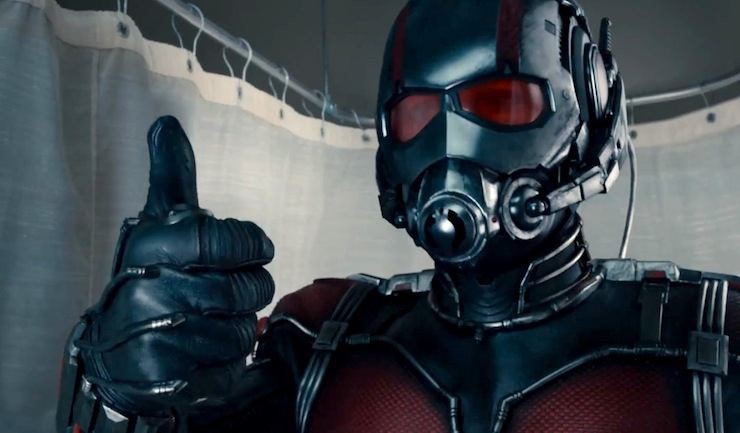The general feeling around Ant-Man has been one of apathy from MCU (Marvel Cinematic Universe) fans, and it’s not all that surprising–with so many hits in the can, the world has been waiting for the Marvel mega-machine to falter. That said, Ant-Man is a truly enjoyable ride full of comical performances.
It’s just isn’t necessary.
The biggest stain on Ant-Man‘s production was the prolonged goodbye from writer/director Edgar Wright (of Shaun of the Dead, Hot Fuzz, and Scott Pilgrim fame), the first person tapped for the project. Wright’s falling out with Marvel was a lengthy, painful thing, clearly the result of everyone trying and then trying again to make it work well past the point of failure. It seems likely that Wright’s primary issue was Marvel’s insistence on working so much of the MCU canon into the film, and once he departed, fans were at a loss. With every breath of promotion, Marvel was assuring moviegoers that Wright’s fingerprints were still all over the film, and from how much attention he receives in the credits, it’s clear that they were hoping to drive that home. And certainly, Wright’s sense of humor lives on in Ant-Man, a sensibility that would have been impossible to stamp out altogether.
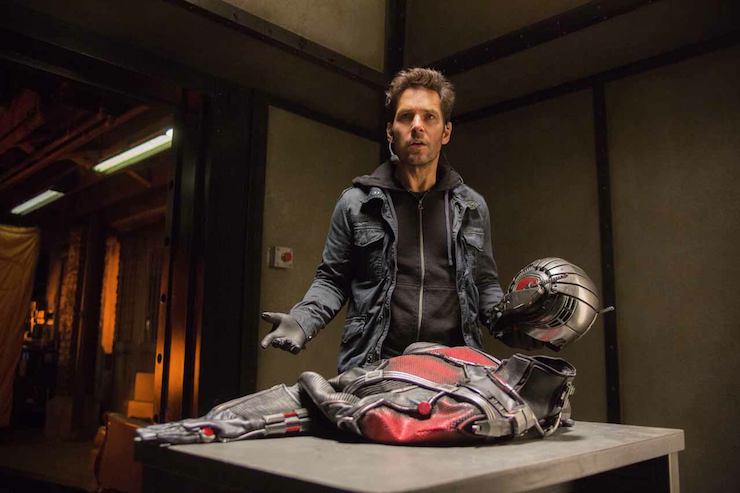
The problem is that much of Edgar Wright’s talent is situated in ways that he marries screenplays with his (unmistakable) visual directing style. Ant-Man is missing Wright’s frenetic energy–his quick cuts, his closeups on inane action, his placement of visual gags. Some of his vernacular remains–his supremely ironic song choices, for example–but it’s not enough to pull the very trite story arc out of the water.
So, as predicted, Wright’s departure did to Ant-Man precisely what everyone feared; it made the movie… just another superhero jaunt. It doesn’t help that plot is a badly rehashed first Iron Man film, right down to a bald villain that wants the Pym particle tech all for himself and his personal aggrandizement. And unlike Obidiah Stane, that villain (Darren Cross, Hank Pym’s former “prodigy”) is grossly obvious from the get-go. He might as well rub his hands together gleefully every time he walks on set for all the evil gloating he’s doing throughout the film.
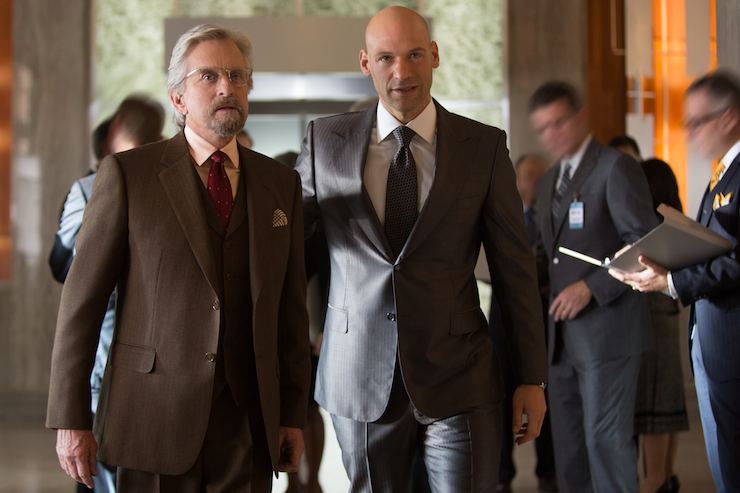
That said, Ant-Man succeeds the best in places where it lets go and tries to enjoy itself. The cast is doing an excellent job of making this little sidelined group of players into heroes worth watching, and Paul Rudd and Evangeline Lilly are charming from the first glance. (Especially Lilly, who has so much presence as Hope van Dyne, she practically forces other people out of the frame when she looks across a room.) The use of the ants is, appropriately, one of the best aspects of the film, and the little guys contribute to every action sequence with a wonderfully unique flare. Fun, too, are Scott’s heist crew, who make up the majority of the film’s laughs, and happily don’t read as boring stereotypes.
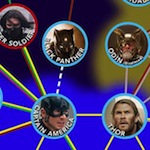
The biggest problem with Ant-Man is that, without Wright’s singular take, this movie isn’t… needed. At all. Fans of Marvel comics likely know Hank Pym (the original Ant-Man, played by Michael Douglas in the movie) for three reasons: he was a founding member of the Avengers, he created Ultron, and he infamously beat his wife within the panels of his comic. None of these elements apply in the MCU, and Ant-Man is barely required for his abilities at this point, certainly not enough to warrant an entire film on his origin. The upcoming films will work to open up Marvel’s universe in ways that are deeply relevant, and not just for the sake of diversifying the cast (though that is incredibly important)–Black Panther’s appearance will expand our world stage, Captain Marvel will undoubtedly deal with humanity’s new frontier in space, Doctor Strange will bring all that is metaphysical and weird. Ant-Man… well, he can be big and then small, and ants really like him. He’s quippy?
Oh wait, we’ve got a bunch of quippy guys already.
(Below this point will be HEAVY SPOILERS for the rest of the film. Do not go past this image if you don’t want to read them!)
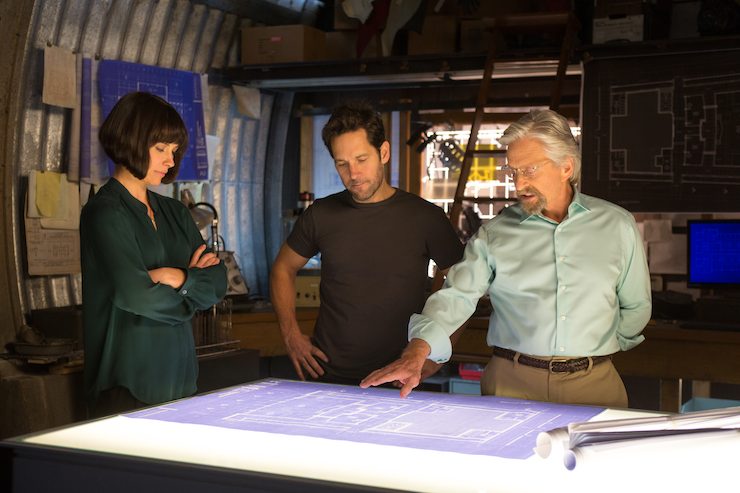
NO REALLY, SPOILERS AHEAD!
In terms of how the film plays with the already established MCU canon, it is delightful if continuity is your beat. The opening shows SHIELD as it existed in the 80s–the HQ that Cap and Company will tear to the ground in Winter Soldier is in the process of being built–and we get to see a middle-aged Peggy Carter and John Slattery’s Howard Stark again. (I desperately wanted this. Dominic Cooper gives his all in Agent Carter and Captain America, but John Slattery’s take on the part feels far more authentic to me, for all that he has played it for a mere five minutes on film.) The CGI used to age down Hank and age up Peggy is still a bit uncanny-looking, but Marvel is determined to use the technology, so I suppose there’s nothing for it.
The next nod arrives when Hank mistakenly uses old intel on one of Howard’s warehouses to fill Scott in on some tech they need to steal–without checking in to find out that said warehouse has been converted into the new Avengers training compound. Scott gets to grapple with Falcon, and Sam Wilson’s appearance is a welcome beat in the plot, reminding the audience of where we are in the Marvel universe while giving Falcon a chance to spread his wings (hur hur) a little. The use of the Cold War propaganda films as background for the Ant-Man figure feels a little wobbly, however; if Pym had been working with SHIELD, doing missions while the USSR was still around, it seems incredibly unlikely that he would have never been name-checked up until this point. Even having Cap or Coulson mention the urban legend of Ant-Man in the first Avengers film would have helped a little, but without it, the origin of the character is a silly sort of blindside.
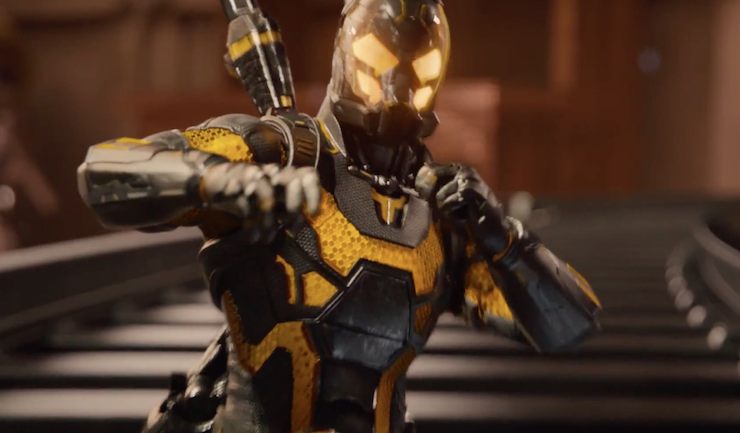
The parallels in the plot are as obvious as they could possibly get–Hank Pym is giving Scott Lang (Paul Rudd’s character is a former thief of a very literal Robin-Hood-type caliber) the chance to make his way back to his young daughter, who he can’t see following his time in prison. The actress playing Cassie Lang (Abby Ryder Forston) is a little ball of incandescent joy, so it’s easy to understand why Scott is so enamored of fatherhood. Hank wants this for Scott because he’s botched his paternal path with daughter Hope (Lilly), who won’t forgive him for keeping the details of her mother’s death from her. We later find out that Janet van Dyne was working with Hank as the Wasp, and died stopping a Russian Cold War missile.
The problem is that Hank’s grief over Janet’s death is used as the primary reason for keeping Hope out of danger–though she’s clearly more capable with the Pym tech than Scott is. Essentially, Janet van Dyne was fridged to give Hank Pym enough pain to prevent Hope van Dyne from being the main character. It would have been a much better (and unexpected) film if that hadn’t been the case. Keep Scott Lang on as the guy who teaches Hope how to be a good thief, as she’s already got the other skills down pat, and let Hope come to terms with her father’s legacy through more than just tears and a good heart-to-heart with pops. Scott Lang is a fun character, but he’s ultimately not anything special as a front man–the Marvel universe is full of guys who are just like him. His desire to be a good dad is the only thing that sets him apart and makes him interesting.
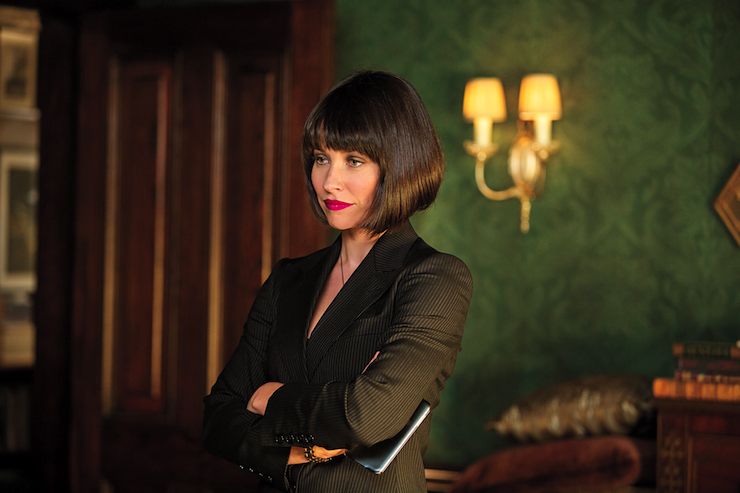
Of course, some will insist that this isn’t a problem because Hope gets her wish in the first post-credits scene of Ant-Man; Papa Hank unveils the Wasp 2.0 uniform that he’d been working on with Janet, and tells Hope that she should wear it. And Hope says what the audience has been thinking from the start: “It’s about damn time.” And in my mind, this is perfect example of how Marvel has managed to have it both ways on representation; they create excellent female characters, then come up with reasons why they cannot be the primary protagonist. Sure, Hope van Dyne will be the Wasp now, but the upcoming roles for she and Scott in the MCU will clearly be as bit players in the big tentpole films, lending a hand during the Civil War and the Infinity War arcs. Marvel figured out a way to make her a hero, but still wouldn’t allow her to take center stage. And she deserved it.
So there were two major fixes that could have made Ant-Man a special addition to the Marvel universe, but Wright was shown the door and then Hope didn’t get her due. While I can recommend the movie for a fun diversion on a hot summer day, it’s not broadening the scope of the MCU in any spectacular way. Which is honestly too bad, because it has the pedigree of something much greater between its frames.
Emmet Asher-Perrin just wants to say… that second tag scene, though. SECOND TAG SCENE. You can bug her on Twitter and Tumblr, and read more of her work here and elsewhere.










